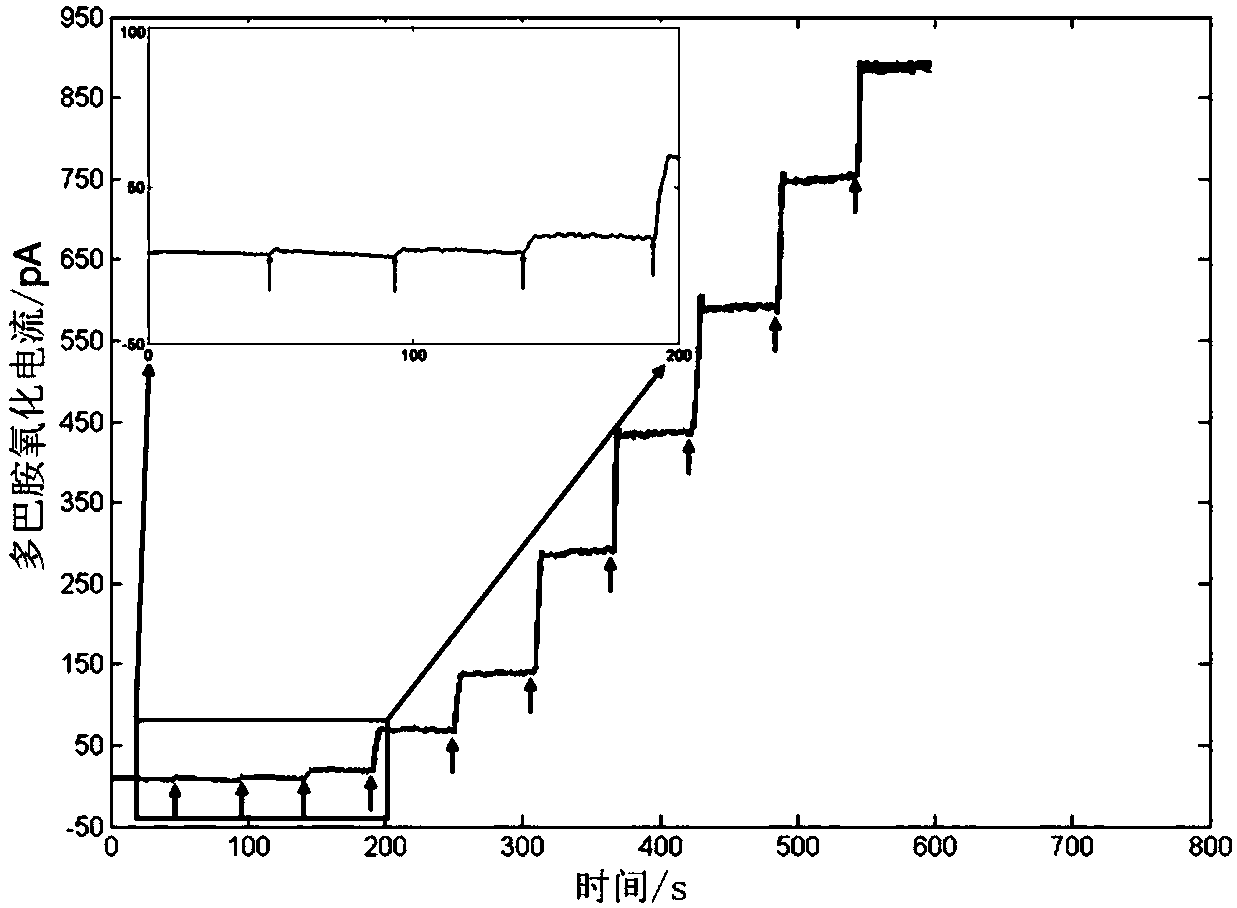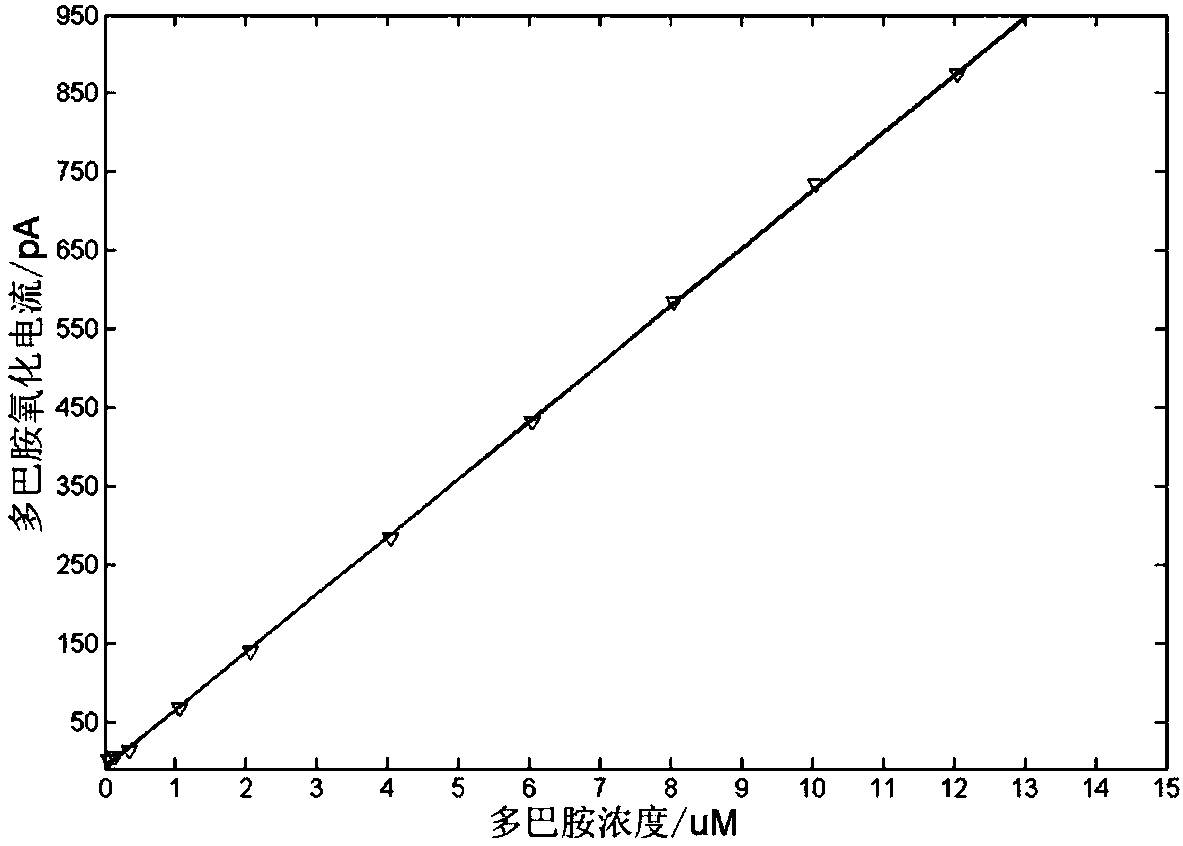Preparation of microelectrochemical sensor for detection of dopamine concentration in animal brain
A technology for concentration detection and dopamine is applied in the field of electrochemical analysis and detection of neurotransmitter dopamine, and achieves the effects of high sensitivity, small volume and simple preparation steps
- Summary
- Abstract
- Description
- Claims
- Application Information
AI Technical Summary
Problems solved by technology
Method used
Image
Examples
Embodiment 1
[0022] Example 1: Preparation of a Micro Electrochemical Sensor for Detection of Dopamine Concentration in Animal Brains
[0023] Step 1: The schematic diagram of the structure of the silicon-based microelectrode array used in this example is shown in figure 1 As shown, including the pad area and the electrode site area of different sizes, each electrode in the electrode site area of different sizes is connected to each connection point on the pad area by electrode leads, and the total length of the silicon-based microelectrode array is 15mm ( That is, the total length from the front tip of the electrode site area of different sizes to the distal edge of the pad area is 15 mm).
[0024] The silicon-based microelectrode array is 300μm-500μm wide, 100-200μm thick, and 8-9mm long. The electrode sites on the surface of the silicon-based microelectrode array are circular gold sites with a diameter of 50 μm, and the circular gold sites are used as electrodes to be modified lo...
Embodiment 2
[0026] Example 2: Working curve drawing for dopamine miniature electrochemical sensor in animal brain
[0027] Step 1: use the dopamine concentration detection miniature electrochemical sensor prepared in Example 1 as the working electrode, the platinum wire electrode as the counter electrode, and the Ag / AgCl electrode as the reference electrode, and put it into an electrolytic cell containing 10 mL of pH=7.4 phosphate buffer In the three-electrode system, and connected to the electrochemical workstation;
[0028] Step 2: Using constant voltage current voltammetry, apply a constant voltage of +0.3V between the working electrode and the reference electrode, and then dropwise add 0.05μM, 0.1μM, 0.2μM, 0.7μM in the case of uniform stirring of the electrolytic cell , 1 μM, 2 μM, 2 μM, 2 μM, 2 μM, 2 μM dopamine standard solution, obtained as figure 2 The dopamine oxidation current step curve is shown.
[0029] According to the relationship between the obtained dopamine oxidation...
Embodiment 3
[0032] Embodiment 3: Anti-disturbance test of miniature electrochemical sensor for dopamine concentration detection in animal brain
[0033] Step 1: The micro-electrochemical sensor for detecting dopamine concentration in the animal brain prepared in Example 1 was used as the working electrode, the platinum wire electrode was used as the counter electrode, and the Ag / AgCl electrode was used as the reference electrode, and 10 mL of pH=7.4 phosphoric acid In the electrolytic cell of the buffer solution, a three-electrode system is formed and connected to the electrochemical workstation;
[0034] Step 2: Using constant voltage current voltammetry, apply a constant voltage of +0.3V between the working electrode and the reference electrode, and then add 1 μM dopamine, 12 μM dihydroxyphenylacetic acid, and 12 μM ascorbic acid dropwise in the case of uniform stirring in the electrolytic cell , 0.5 μM dopamine, 1 μM dopamine solution, wherein dihydroxyphenylacetic acid and ascorbic ac...
PUM
| Property | Measurement | Unit |
|---|---|---|
| diameter | aaaaa | aaaaa |
| diameter | aaaaa | aaaaa |
| diameter | aaaaa | aaaaa |
Abstract
Description
Claims
Application Information
 Login to View More
Login to View More - R&D
- Intellectual Property
- Life Sciences
- Materials
- Tech Scout
- Unparalleled Data Quality
- Higher Quality Content
- 60% Fewer Hallucinations
Browse by: Latest US Patents, China's latest patents, Technical Efficacy Thesaurus, Application Domain, Technology Topic, Popular Technical Reports.
© 2025 PatSnap. All rights reserved.Legal|Privacy policy|Modern Slavery Act Transparency Statement|Sitemap|About US| Contact US: help@patsnap.com



